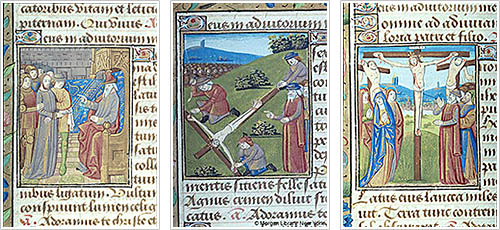Beyond The Bible: A Case Study in Pontius Pilate and How His Role was Extended in The Passion
Introduction
This study was inspired by a query posed to me some time ago as to who was the wealthy, lavishly clothed Jewish man at the foot of the cross. It was Pontius Pilate, a subject I had been studying for a number of years[1]. This paper looks at some unknown aspects of the visual life of the alternative Pilate—outside the Bible—to see what was and was not illustrated. (Fig. 1)
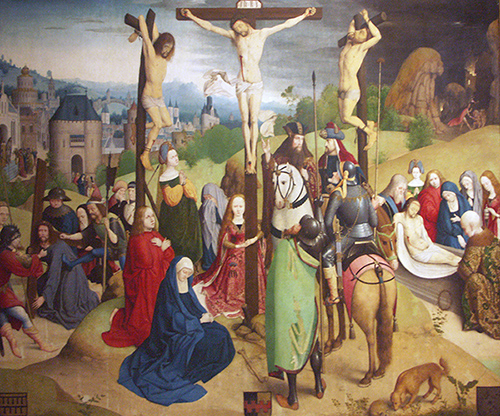
Photo: Author
Fig. 1: The Crucifixion, now in the Wallraf-Richartz Museum, Cologne,
inv no. WRM 473, German circa 1480.
It is clear that iconography, of course, does not have to be linked to a textual correlate. However, it is also understandable that iconographers are far more comfortable in dealing with subjects that can be linked to a textual correlate. Such texts seem to provide a security that enables us to know what is being represented. For Pontius Pilate, there are few canonical textual correlates for so pivotal a figure, but a significant corpus of apocryphal material exists that when taken together with the canonical, is substantial. We know nothing factual of Pilate prior to his appointment as procurator in Judea in 26 AD that ended in 36 AD. Most of this centers on his role as administrator and even then we know little. The earliest canonical images of him—from the fourth century onwards—focus simply on his administrative role in the trial and on his washing of his hands in particular. The canonical facts are relatively limited and describe in emotive but impartial terms Pilate’s judgment of Christ and his efforts to have him freed.
There are some Pilatian episodes that although not actually documented in the canonical, can be inferred as having taken place. For example, we know that Christ did not just go on his own or of his own free will to either the High Priests or to Pilate himself as part of the trial sequence but that he was brought or led to them—so a representation of Pilate being sent to the High Priests or Christ being led to Pilate although not specifically linked to a textual correlate in the Bible makes perfect sense. An event such as this forms a natural part of the textual narrative and even if it is not described textually we can believe that it happened. It forms part of the expected sequence.
Similarly, it is also possible to go slightly beyond what the canonical states to enhance it. Such small liberties sometimes make perfect sense as the original basis is there. This is even more so in the case of a slightly undefined or nebulous textual source. For example, it is Luke who first records that “Herod and Pilate were made friends that same day; for before they were enemies one to another” (Luke 23:12). The concept of friendship in itself allows for visual liberties and of course these were extended here. Over time, and largely in response to a variety of needs various textual legends arose as to the nature of their friendship, and it varies from them being father and son, to brothers, to them both being seen as Jews—which, of course Pilate never was in reality. The friendship between the two becomes an interesting visual topic in the thirteenth century. This friendship between Pilate and Herod is usually seen as involving Pilate as a willing conspirator in Christ’s death. This is just one example of an iconography that can be easily understood as it has a recognizable textual correlate that has been modified and extended in response to outside factors, but at the same time it remains true to its original.
I would like to examine the visual evidence for Pilate’s involvement in the crucifixion to see what that tells us. It focuses on what has long been a problem for historians: to see if Pilate was ever present at the Crucifixion itself. There are some scholars who see him as being there while others do not and this paper examines the visual evidence to determine if indeed he has been there all along, and why he may have been overlooked.
According to the Bible, Pilate’s main role in the passion ends with his presenting the bloodied and bruised Christ to the people which is usually called the Ecce Homo scene[2]. There are two post-crucifixion episodes that are both described in the Bible and center on Joseph of Arimathea asking for Christ’s body before Pilate (Mt 27:58, Mk 15:43–45, Lk 23:52, Jn 19:38) and Pilate asking to guard the sepulcher (Mt 27:62–66, Lk 3: 1, 13:1 and 20:20). Nothing else is mentioned of Pilate, and his presence at the crucifixion is not recorded. It would appear that his involvement with Christ ceased after sentence had been passed. It is not clear if Pilate actually went to see the sentence meted out. The implication is that he handed Christ over to the soldiers and did not go to Golgotha to see Christ die. There has been considerable scholarship as to whether or not he was at the foot of the cross when the titulus (title placard) was placed on it. This is recorded in John 19:19–22: “And Pilate wrote a title, and put it on the cross. And the writing was Jesus of Nazareth the King of the Jews.”
It is possible that the titulus was simply handed over after he had written it. To my knowledge there are no images of Pilate actually “putting it upon the cross” as John states. Images such as that in the Holkham Picture Bible (London, British Library, Ms. Add. 47682, fol. 31v) show him actually writing it at the foot of the cross[3] (Fig. 2).The titulus has been well researched, and I will not deal with it in this paper, but it may be one element which was used to show that Pilate was indeed present at the crucifixion[4]. Instead, it is the crucifixion and the immediate scenes leading up to it and Pilate’s involvement in them that is the focus of this study. If the modern day Stations of the Cross are examined Pilate is shown in only one scene and yet it is my belief that he was in fact present at others that we may have not yet identified him, and that is what I will do in this study.
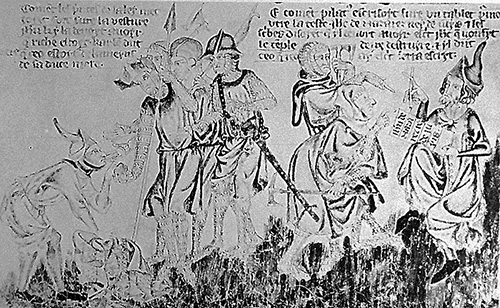
Photo: Index of Christian Art
Fig. 2: Casting lots for Christ’s garments (left side) and Pilate writing the
titulus (right side). Detail from the Holkham Picture Bible (London,
British Library, Ms. Add. 47682, fol. 31v). English, circa 1320–1340.
Traditionally, when we look at Crucifixion scenes we can identify the three crosses with Christ, Dysmas, and Gestas, the Virgin, Saint John, the Magdalene, the centurion, the soldiers playing dice for Christ’s cloak, and Stephaton and Longinus, but we also have to admit that sometimes there are many more figures that we have never identified or examined closely, some of whom are represented in considerable detail. They can’t all be simply soldiers or onlookers—some of them stand out for the opulence of their clothing or for some gestural language or detail which singles them out as important.
From the outset, there is nothing in the records to state that Pilate was ever required to be present at the event. As judge and administrator there is every reason to believe that he was required to be there to see a sentence fulfilled, but it is also possible that his role ended with the formal sentence. He would, after all, have had many trials to oversee, and he may not have gone to see all the sentences carried out. Biblical scholars are inclined to believe that he was not actually there or, in fact, they state that there is no evidence that he was ever there. Of course, Pilate does not need to be at the event in much the same way that Herod was not present at the massacre of the innocents—responsibility lay with both of these rulers. However, it is interesting to see why and when he was represented as being there.
I believe that the visual records show him to have been there and to have had a far more active role after the Ecce Homo scene than has hitherto been suspected. This is not unusual as he also seems to have had a far greater involvement in the flagellation, mocking, and crowning with thorns than has been suspected (Fig. 3–4). As the need to highlight Christ’s suffering and to extend the negative qualities of the Jewish High Priests increased in the Middle Ages so also did their role in Christ’s suffering, and amongst the High Priests we also find a Jewish Pilate meting out this punishment. There are several instances where it is a Jewish Pilate alone who flagellates Christ, crowns him with thorns, and mocks him. Neither soldiers nor High Priests were necessary to be present, and it is clear that Pilate alone could do all that was necessary.
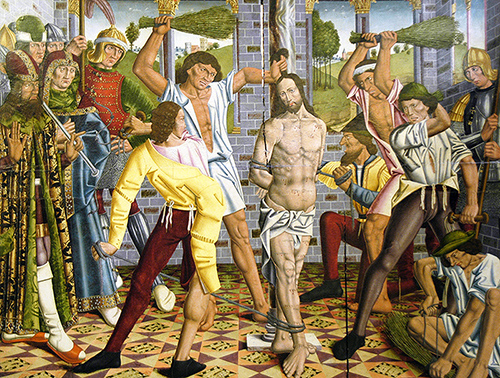
Photo: Author
Fig. 3: The Flagellation. Both Figs. 3 & 4 show an opulently dressed Pilate wearing the same distinctive clothing and footwear. Pinturas del Armario de las reliquias by Antonio da Sedano, Burgos, Cathedral Museum, circa 1495–96.
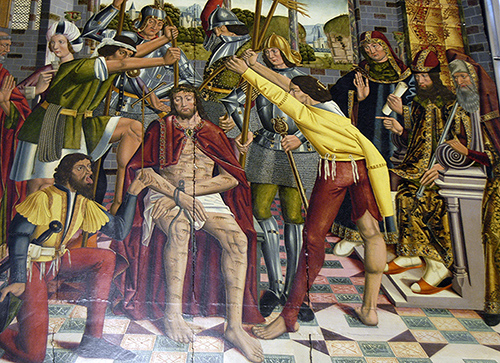
Photo: Author
Fig. 4: Crowning with Thorns. (See Fig. 3 caption above.)
Christ Nailed to the Cross
The earliest examples of Pilate being present after the judgment had been passed focus on his role in the actual nailing of Christ to the Cross and date to the fifteenth century. This is the scene where Christ was nailed to either a horizontal or vertical cross that immediately precedes the crucifixion. There are numerous examples—nearly all of which show the nailing to the cross being directed or at the least observed by a well dressed figure with distinctive headdress or scepter—usually seen as two of Pilate’s most recognizable attributes. By the sixteenth century there is little doubt that it is Pilate who is intended. In nearly all of these works he wears the same distinctive clothes in the scenes leading up to the crucifixion as well as at the event itself, and it differs from what the other figures wear in the same manuscripts.
Typical of such a work is the Book of Hours now in The Morgan Library, New York (Ms. 261) that was illuminated by Robert Boyvin circa 1495–1503. It has three miniatures in which Pontius Pilate is represented (fols. 76r, 77r, 77v) and these show Christ before Pilate, the Nailing to the Cross, and the actual crucifixion with Pilate at the foot of the cross. (Figs. 5, 6, 7) In all three miniatures he wears the same costume and has the position of authority that would be expected of him. There is little doubt that it is the same figure who is intended in the three paintings. This example is not unique, and many other examples exist.
(Click image for larger picture; 1.2MB.)
Photos: Morgan Library and Museum
Figs. 5–7 are miniatures showing Christ before Pilate, the nailing to the cross and the crucifixion from a book of hours illuminated by Robert Boyvin, circa 1495–1503 now in The Morgan Library, New York (Ms.261, fols. 76r, 77r, 77v). Pilate wears the same clothing in all three illuminations.
The Crucifixion
If Pilate could be seen at the nailing then it is logical that he could also be found at the crucifixion itself—at the foot of the cross—heightening the emotional drama even further. This is found especially in the fifteenth and sixteenth centuries when crucifixion scenes become crowded and heavily peopled, particularly in panel paintings; Pilate is frequently found amongst the rabble at the foot of the cross (Fig. 1). This figure has not been identified to date and is usually described as one of the soldiers. It is not the Centurion who is intended as his gestural language and clothing is usually different. Many figures can be found at the foot of the cross ranging from Saint Francis, patrons, the soldiers playing dice to those flinging stones at Christ, but standing or else seated on his horse is the figure of Pilate. By including Pilate in this scene, his role and culpability is heightened even further. This entire iconography has to be seen as part of devotional literature with its focus on the suffering Christ and the wickedness of the tormentors.
This iconography is rare before the fifteenth century, but there are some interesting and early examples. The earliest examples I have found come from the bible moralisée and they show figures which in some cases may be identified as simply non-believers as in the Vienna manuscript (Codex Vindobonensis 2554, fol. 57v) or the example in the Bodleian Library (Oxford, Bodleian Library, Bodley 270b, fol. 25v), but the example in the British Library (Harley 1526–7, f. 121r) poses different and more difficult problems. Pilate is found here at the foot of the cross, but in another image in the same manuscript it is possible to see two other figures who may represent either Pilate or non-believers. Their position to Christ’s right side is unusual, and they are opposite Moses and other figures. Their wearing pointed Jewish hats may show them to be non-believers and, if so, they may represent Pilate and Caiaphas. Pilate and Caiaphas are closely linked in later Passion scenes and become commonplace at the start of the fifteenth century. Elsewhere, Pilate is found at the foot of the cross, and there is little doubt that the blackened figure on the left hand side of Christ in the crucifixion scene in the Luttrell Psalter (British Library, Ms. 42130, fol. 94r) is Pilate standing with his usual attributes of scepter, crown, and blackened face.
By the fifteenth century Pilate is a near-standard figure in this scene but has as yet not been identified as the procurator. He is immediately identified by the opulence of his clothing and his prominent position where he is most frequently shown on horseback at the foot of the cross in conversation with the High Priests. The image in the Croesnick Hours (New York, Morgan Library, M. 1078, f. 52v), for example, shows Pilate dressed in an ermine hat and trimmed robes—his near standard clothing for the fifteenth century, and standing at the foot of the cross—the same clothing that he wears in the scene of Christ before Pilate some two folios earlier (Figs. 8, 9). These images further extend Pilate’s negativity and guilt in Christ’s death.
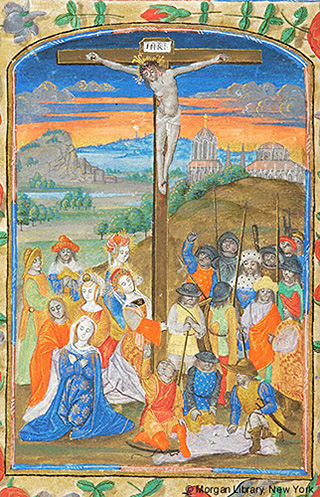
Photo: Morgan Library and Museum
Fig. 8: The Crucifixion, Croesinck Hours,
Morgan Library, New York, Ms. M.
1078, f. 52v, Dutch, circa 1494.
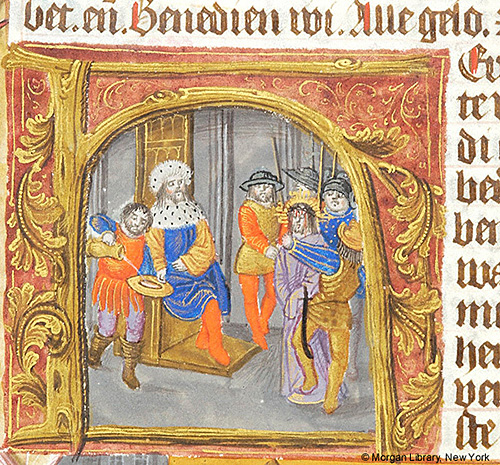
Photo: Author
Fig. 9: Christ before Pilate, Croesinck Hours, Morgan Library, New York,
Ms. M. 1078, f. 44v, Dutch, circa 1494.
The drama of the late middle ages firmly places Pilate at the event. The “Townley Plays”(Crucifixion Play XXIII), for example, has Pilate giving a long winded, pompous speech in which he proclaims himself to be the great lord, prince of all Jewry, and next only to King Herod. He also has Christ’s robe at the foot of the cross that was won fairly by the torturer who was then pressured by Pilate into handing it over to him—an undignified theft even for Pilate. (The Talents, Play XXIV). In the York Cycle (Christ’s Death and Burial Play) Pilate is accompanied by Caiaphas and Annas on what is clearly a dais set up for them to observe the crucifixion. Here, it is Pilate who holds a long conversation with Annas and Caiaphas at the crucifixion, and who instructs Longinus and Nicodemus from his dais. As such, his role has been extended in these proceedings to make him a central character.
Carrying of the Cross
If Pilate is found at the actual crucifixion, he could also be shown at the beginning of the road to Calvary with the carrying of the cross. Since the early Christian period, the washing of the hands has traditionally been linked to the carrying of the cross. This was when Passion scenes were not as numerous as they were to become in the later period. In the late medieval period—from the fifteenth century onwards—Pilate is frequently found in scenes of the Carrying of the Cross. He is often represented mounted and immediately behind Christ in this scene, particularly in images from the Low Countries. It does not seem to have been a popular theme before this date. Typical of this work is the fifteenth century “Beatty Rosarium” by Simon Bening (Dublin, Chester Beatty Library, Ms. CBI WMS 99) where Pilate clearly wears the same identifying clothing in all five miniatures in which he is found.
Conclusion
In many ways the inclusion of Pilate in scenes of the Carrying of the Cross, the Nailing to the Cross, and the Crucifixion itself is perfectly logical as it provides an end frame for us to his actions. If Judas can be seen as initiating the betrayal and passion from the human perspective then Pilate is the formal and legal beginning through to the conclusion. I believe there is little doubt that he was represented in all these scenes towards the end of the Middle Ages. We shall never know in reality if indeed he was present at these events, but it is clear that he was shown as being there. I believe that closer examination of these scenes will pay dividends in the future and show us that Pilate’s role was much more involved than was previously believed.
Notes
1 See Hourihane, C. Pontius Pilate, Anti-Semitism and The Passion in Medieval Art (Princeton, 2009).
2 See Hourihane (as in note 1), 220—26.
3 M. Brown, The Holkham Bible, Picture Book, a facsimile and commentary, (London, 2007) 76—7.
4 Amongst those who have studied it are Sarfatti, G, Pontani, A. and Zamponi, S., “Titulus Crucis” Giotto: la Croce di Santa Maria Novella, (Florence, 2001), 191—202 and Henkel, N., “Titulus und Bildkomposition: Beobachtungen zur Medialität in der Buchmalerei anhand des Verhältnisses von Bild und Text im Bamberger Psalmenkommentar” in Zeitschrift für Kunstgeschichte LZII (1999), 449—63.

